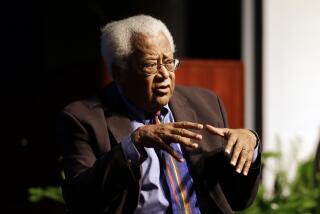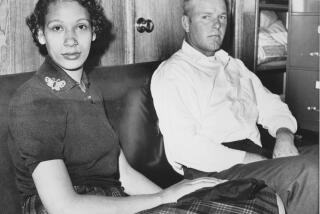He Enjoyed the Fight : THURGOOD MARSHALL: Justice For All <i> By Roger Goldman with David Gallen</i> , <i> (Carroll & Graf: $24.95; 479 pp.)</i>
Thurgood Marshallâs family lived on a good street in Baltimore when he was growing up before the First World War, but there were tough kids on the street behind them. At dinner time his mother would go to the front door to call his brother, and then to the back door to call him.
Marshall was a lively boy, often in trouble at school, and he grew into a big man, over six feet tall, barrel-chested and forceful. He grew up a fighter, and like any old soldier he had a lot of stories to tell: tales of late-night parties in Harlem with Joe Louis; of trips to the South for the National Assn. for the Advancement of Colored People in the 1940s; of telephone calls from the President of the United States.
He led the attack in the courts against legal segregation, and he argued and won Brown v. Board of Education. Long after he had joined the Supreme Court, he said: âI enjoy the fight. I agree with the old saying, âI love the peace, but I adore a riot.â â In recent years, when the questions about retirement came, he said, âI have a lifetime appointment and I intend to serve it. I expect to die at 110, shot by a jealous husband.â
Marshall, as NAACP attorney and Solicitor General, had helped the Court to open the doors of all the institutions of public life, and to the places of public discourse. Furthermore, he resisted the intrusion of those public institutions into the private realm. He had a lively sense of the daily life of all sorts of people, and a concrete understanding that for many people, especially the powerless, government was an oppressive, intruding force that, even without intending to do so, could blindly obliterate privacy and individual belief.
He was appointed to the Supreme Court in 1967, at the height of Lyndon Johnsonâs fight to remake the world; Marshall and Johnson, we are told, sometimes shared a bottle of bourbon. Marshall, like Johnsonâs two other appointees, Justices Abe Fortas and Arthur J. Goldberg, was prepared to take the Court much further into the battle for social justice than it had yet ventured. The aging Earl Warren was chief justice, and the Warren Court, by 1967, had struck down legal barriers blocking the schoolroom and the courtroom and voting booth.
But the Warren Court had exhausted its initial impulse. As a justice, Marshall began to argue for a more profound set of changes in Constitutional law. An open courtroom door meant nothing to the poor. Equal access to the institutions of public life meant very little, in Marshallâs view, without affirmative programs to repair the destruction wrought by past injustice, and to provide the minimum means of a decent life: âThe intent of the Fourteenth Amendment was to abolish caste legislation. . . . When state action has the predictable tendency to entrap the poor and create a permanent underclass, that intent is frustrated.â
In âThurgood Marshall: Justice for All,â St. Louis University law professor Roger Goldman (with co-author David Gallen) argues that in a more sympathetic Court, Marshall would have held government to an affirmative obligation, as a matter of Constitutional right, to provide a minimum of subsistence, health care and education to everyone. Marshall would have carried out in Constitutional law the equivalent of the social reforms that President Johnson was embarked upon.
This revolution--and it would have been a revolution--foundered. Goldberg and then Fortas were taken from the Court; Johnson himself retreated from the presidency in defeat, and in 1969, a new President appointed a new Chief Justice. Marshall was thenceforth in a minority; before his retirement it would shrink to a minority of two in many cases, and after Justice William J. Brennan retired, Marshall often dissented alone. He wrote hundreds of dissents, and while not always eloquent, these opinions were both passionate and dignified. In the civil-rights cases that were his lifeâs work he, like Justice Oliver Wendell Holmes 60 years earlier, was able to rise above the Court, seemingly above the law itself:
âDesegregation is not and never was expected to be an easy task. Racial attitudes ingrained in our Nationâs childhood and adolescence are not quickly thrown aside in its middle years. . . . In the short run, it may seem the easier course to allow our great metropolitan areas to be divided up each into two cities--one white, the other black--but it is a course, I predict, our people will ultimately regret.â
This moral quality of his decisions, compelling as it was, posed a dilemma. Marshall dissented in writing 150 times, Justice Brennan tells us in this book, just from the decisions of the Court not to review death penalty cases. His respect for precedent was selective; only affirmations of rights really told for him. The Constitution was not sacred writ to Justice Marshall; if a reenactment of the Constitutional Convention were held in Philadelphia, he said, he would have to wear knickers and serve the tea. The Constitution, in Marshallâs jurisprudence, is what the Court has made it; and the Constitutional rights of individuals, as against the government, trump all other legal claims. I think he would greet with amused contempt the argument that rights have been pressed to their limits.
This is the jurisprudence of an advocate. How he would have decided cases if he had not been in a besieged minority of the Court, we do not know, and perhaps he does not know. But the time for scholarly evaluations, and the verdict of history, is not yet. By any standard, Justice Marshall is one of the great Americans of his time, one of the shapers of history; and there is no doubt that looking back, our children will see his noble head rising above nearly everyone around him in his generation. This book gives a snapshot, if not a portrait in the round.
Goldman and Gallen donât particularly emphasize that Marshall was the first African-American justice. His accomplishments were on a larger scale than that. But one of the questions scholars are picking over, and that is not addressed in this book, is whether Marshallâs work was enriched by something identifiably African-American; whether his is an African-American âvoice.â
Justice Brennan remarks in this volume on the unique quality of Marshallâs voice on the Court, which Brennan calls a voice of authority. Marshall is noticeably more sensitive than his colleagues have been to the concerns of an individual facing an oppressive state; Marshall knows that the government official people most often meet is the policeman. He is sensitive also to the small ways in which ordinary people establish their individuality, through dress and haircuts; and the ease with which government can destroy these badges of identity and close off the little channels of expression. He is conscious of the variety of life styles and their fragility.
I donât know if any of this, or his righteous anger or his refusal to be silenced or soothed, is an African-American voice. It is certainly a voice unlike that of any other justice, and we would have lost his rich moral identity if he had been barred from the Court by his skin color. Marshallâs remarkable contributions to American life are themselves a demonstration of the value, the simple usefulness, of opening the doors.
It would be easy to find fault with âThurgood Marshall: Justice for All.â David Gallen âcreatedâ it by assembling some previously published materials, including 15 (out of more than 900) of Marshallâs opinions, and adding a new essay by Goldman. The package is hastily put together.
But I think persnickety criticism would be wrong. Gallen and Goldmanâs book is plainly meant to honor Marshall at the time of his recent retirement, and it is a hearty tribute. It is fine to have it, just as it is, just now, as Marshallâs era ends and a new one opens. I hope Clarence Thomas reads it.
BOOK MARK: For an excerpt from âThurgood Marshall,â see the Opinion section, Page 3.
More to Read
Go beyond the scoreboard
Get the latest on L.A.'s teams in the daily Sports Report newsletter.
You may occasionally receive promotional content from the Los Angeles Times.










